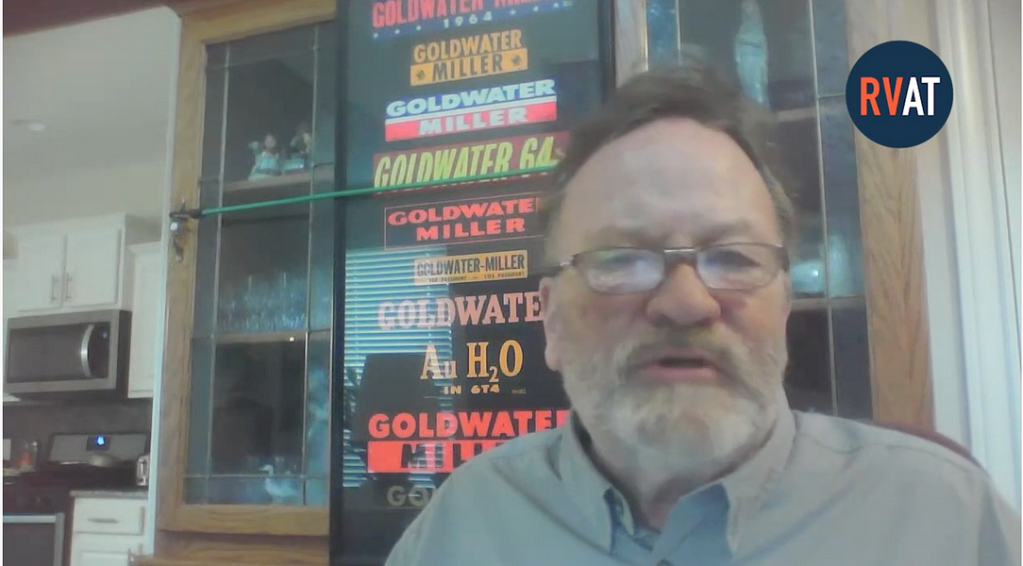Twenty percent of Donald Trump’s own voters four years ago held an unfavorable opinion of the man as they cast their ballot for him on Election Day, according to exit polls. Sixteen percent said they would feel “concerned” or “scared” if he won, and 29 percent viewed him as dishonest. A recent Gallup survey found the GOP shrinking dramatically in size this year alone: 47 percent of respondents identified as Republicans or Republican-leaners in January; just 39 percent did in July. The Gary Johnson-led Libertarian ticket received a record 4.5 million votes in 2016—3.2 million more than Johnson won in 2012—in large part due to the unpopularity of both Trump and Democratic nominee Hillary Clinton.
These are the voters being targeted by two super PACs launched this year—Republican Voters Against Trump (RVAT) and the Lincoln Project—in the hopes of making Donald Trump a one-term president. And with Trump’s margin of victory in 2016 coming down to about 80,000 votes in three states, it just might work.
“This is a massive group,” said Tim Miller, political director for RVAT and longtime GOP operative who most recently worked for Jeb Bush’s 2016 presidential campaign. “You can’t win primaries with that group, that’s true. But in a general election like this, you’re talking about 15 to 20 million voters. And that is the difference between Trump winning a narrow electoral college victory and losing in a Reaganesque landslide.”
The Trump campaign proclaims not to be fazed. “This is the swamp—yet again—trying to take down the duly elected President of the United States,” spokeswoman Erin Perrine told The Dispatch. “President Trump is the leader of a united Republican Party where he has earned 94 percent of Republican votes during the primaries—something any former president of any party could only dream of.” (Trump did win 94 percent of the vote in his primary against former Massachusetts Gov. Bill Weld, but several state GOPs canceled their contests entirely, citing precedent established under previous incumbent presidents.)
Miller and Perrine both have vested interests in the outcome of the race, of course, but other GOP consultants seem to agree with Miller’s assessment. “Nationally, probably close to 20 percent of the Republican vote is available to Biden or to be sidelined,” California-based strategist Rob Stutzman told The Dispatch. “That’s just a substantially weakened base and absolutely can throw the election against Trump.”
There are data models showing Biden/GOP Senate leaners that far exceed the numbers required to flip a number of swing states, a Republican operative working on Senate races this cycle said. “We’re only talking about fewer than 80,000 Republicans across three Great Lakes states.”
Republican Voters Against Trump
The videos are not high quality. Most appear to be shot on a laptop or front-facing phone camera. But there are a lot of them.
“I cannot fuckin’, I can’t take this anymore,” says Jeffrey Farmer, a 50-something-year-old man with neck tattoos whose accent makes sense once he reveals he’s from Mendon, Massachusetts. He voted for Donald Trump in 2016 because he couldn’t stand Hillary Clinton, but he’s throwing his support behind Joe Biden this November. “Him and his goddamn Twitter, all he does is watch the goddamn news. Why don’t you do your frickin’ job, Donald Trump, instead of frickin’ whining and complaining about everything. Everyone’s out to get you? You know what dude? Walk a mile in my shoes.”
Lori sent her video in from a small town in southwestern Wisconsin. She voted for Trump in 2016 because she wanted someone to “do something about all of the illegal immigrants” from Mexico. But she regrets it. “I find myself everyday, almost in tears with my fear of what this man has already done to our country, and what he’s going to do if he gets four more years.”
Charles became a conservative after listening to William F. Buckley and reading Barry Goldwater’s Conscience of a Conservative, and he prayed in 2016 that Trump would “rise to a moral leadership.” But the veteran (he retired a lieutenant colonel) and longtime Southern Baptist pastor from central Texas has seen enough. “I have devoted my lifetime, proud to be an American, to be a conservative, to be a Republican, as a lawyer, as a serviceman, as an Evangelical Christian,” he starts. “Mr. Trump has tarnished all the good that I have stood for. And it saddens me to say that I cannot—I will not—vote for that man.”
Those are three of the hundreds of testimonials RVAT has collected in recent months from GOPers and onetime supporters of the president who now want him booted from the White House. Soliciting the first 100 videos was hard, Sarah Longwell, RVAT’s strategic director, admitted. The group relied on the email list of its parent organization, Defending Democracy Together (DDT), which was stood up in 2018 by Longwell and Bill Kristol to understand and confront Trumpism within the conservative movement. But since that initial batch went live at the end of May, momentum carried the day.
“It’s been overwhelming, honestly, the deluge of videos we’ve gotten in,” Miller told The Dispatch. “We’re over 500 now, it’s been almost all organic. Just people who’ve seen them online or seen the news coverage of them, and decided they wanted to tell their story.”
Longwell and DDT have been conducting focus groups since 2018 in an attempt to figure out what makes Trump voters tick and where the president’s weak spots with his base are. “These Republican voters did not trust Democrats. They do not trust the media. They don’t trust political ads,” Longwell said. “When you show people the stuff with the scary voiceovers, or the stuff that’s attacking Trump, people immediately doubt the source of it. They don’t believe the facts that are contained in there. They know that you’re trying to persuade them.”
Enter: Testimonial videos.
“When it comes to the real voices,” Longwell added, “they’re just so interested in the people’s stories and they really feel like it speaks to the same anxieties that they have about Trump.”
“Politics is very tribal, and so we’re trying to create kind of a new tribe,” she continued. “People who identify as Republicans, who are lifelong conservatives, but who either left the Republican Party because of Trump, or people who voted third party in 2016 because of Trump but this year are going to vote for Biden, in 2016 voted for Trump but in this year are going to vote for Biden.”
It’s a tried and true tactic in the political campaign world. Stutzman described the videos as “classic Advertising 101 permission structures.”
“It’s not so much the persuasion at this point,” he said, “as much as I think [it’s] that permission structure for Republicans to go, ‘Yeah, okay. I don’t have to vote for him again. I can feel okay about that.’”
“It’s okay to change your mind,” an RVAT video with 1.5 million YouTube views concludes. “We did.”
The clips themselves routinely go gangbusters online, racking up millions of views and thousands of retweets, many of which undoubtedly come from liberals desperate to find validation from the other side of the political aisle. But RVAT is working to make sure its intended audience sees them, too.
The group already has $10 million from donors “100 percent committed,” per Longwell, and is hoping to raise an additional $5 million between now and Election Day. Miller says 80 percent to 90 percent of that money will be going toward Facebook and YouTube advertising in states like Arizona, North Carolina, Pennsylvania, and Wisconsin, with the remaining 10 to 20 percent going toward TV spots on shows with “more gettable Trump voters” like Chris Wallace’s Fox News Sunday and Bret Baier’s Special Report.
Officially, Republican Voters Against Trump is not advocating for anything other than what’s in the name. They’re agnostic as to whether the people they’re targeting pull the lever for Biden, stay home, vote third party, or write in their dog’s name. “From a strategic standpoint, taking somebody that last time voted for Donald Trump but just can never get there on the Democrats—maybe it’s because of abortion, maybe it’s just a mental block—just moving them from Trump to write-in, let’s say, has the same value as moving a [Evan] McMullin voter to Biden,” Miller said. “Either way, that’s a plus one for Biden. So while the broader effort of our group is to elect Joe Biden—we’re not hiding the ball on that—we want people that maybe might not vote for him to be part of this effort.”
RVAT is also not campaigning against downballot Republicans. “We’re trying to attract voters who might be Biden-Tillis voters … Biden-McSally voters,” Miller added, referencing the North Carolina and Arizona Republican senators fighting to retain their seats. “This is not going to be a huge segment of the electorate. But it is a segment. … In a close election, that could be the difference.”
The Lincoln Project
It is on this point where RVAT diverges from its more notorious counterpart. The Lincoln Project—announced in December 2019 by political operatives Steve Schmidt, Rick Wilson, and John Weaver, as well as conservative lawyer George Conway—was founded, according to its website, with a singular mission in mind: “To defeat Donald Trump and Trumpism.”
That second part—“and Trumpism”—is what has gotten the Lincoln Project so much flak from the right while RVAT has flown largely under the radar. The group is focusing its tens of millions of dollars not just on helping Joe Biden’s odds in the presidential election, but defeating vulnerable Republican senators—like Thom Tillis, Martha McSally, Susan Collins, Cory Gardner, Joni Ernst, Lindsey Graham, Steve Daines, and Mitch McConnell—as well. Weaver—who has worked for Sen. John McCain and former Ohio Gov. John Kasich but also the Democratic Congressional Campaign Committee—recently told the Washington Post he thinks the Lincoln Project will remain active in a hypothetical Biden presidency, working against GOP lawmakers who oppose Democrats’s agenda.
Schmidt—an alum of campaigns for George Bush, Arnold Schwarzenegger, and McCain—explained the organization’s rationale. “The Republican Party has been a collaborationist party with regard to Trumpism,” he told The Dispatch in an interview earlier this week. “Trumpism is an illiberal, undemocratic, authoritarian-fetishizing movement. And we need two liberal parties in this country debating each other. If there’s only going to be one liberal party, and that party’s policies are going to be progressive, then so be it. We can’t have an authoritarian party in this country, and there has to be a political price to pay for the senators who have let Trump run amok. … It’s the nuttiness of the Republican Party, more than anything else, that’s going to achieve the implementation of a progressive agenda in this country.”
Asked about the argument—advanced by The Dispatch’s David French among others—that burning down the GOP indiscriminately will leave nothing but the Trumpiest members, Schmidt didn’t necessarily see that as a problem.
“The Matt Gaetz, Jim Jordan, lunatic fringe of the party is a specific type of metastasis of the cancer that’s in our politics. These guys are nuts and fools,” he said. “In some degree, the [Sen.] Susan Collinses and the [Sen.] Cory Gardners are worse than all of them because they know better. And their issue is cowardice. … Nobody is asking any of these people to have stormed Omaha Beach, right? They’re senators, they’re not victims.”
Schmidt referenced The Wave—a 1981 made-for-TV movie about a group of students unknowingly descending into fascism—to explain present-day American politics. “Could it happen here?” he asked. “It is happening here.”
“Porn for MSNBC viewers” is how Stutzman referred to the Lincoln Project and its political advertising. Current Republican operatives have taken to calling the group a Democratic super PAC, citing its donor rolls, which, as of June 30, feature scores of prominent large-dollar Democratic donors in addition to its more grassroots fundraising. Its offerings are “wildly popular in Democrat Twitter, in places like MSNBC,” Stutzman continued, “because it’s so cathartic and satisfying. But I don’t know that it’s particularly persuasive to Republicans.”
The group’s ads buck nearly all the insights gleaned from DDT’s focus groups. They feature scary voice-overs, include plenty ofTrump mocking, and focus on inside-the-Beltway stories that don’t matter to voters. But RVAT staffers think their more aggressive peer is complementary to their own efforts, targeting a different slice of the electorate—and one person in particular.
The Lincoln Project characterizes itself as “having an audience of one, trying to get in Trump’s head,” Longwell said. “That’s what they’re doing. What we’re doing is we are narrowly focused on deep persuasion of our target audience.”
Schmidt did not reject the notion that his group engages in what Miller referred to as “PSYOPS” (psychological operations) against the president. “We were the first people to point out [Trump’s] stumbling down the ramp at West Point and drinking water. Fast forward to [his] Tulsa [rally], for 45 minutes he goes up and talks about drinking water and walking down the ramp, which makes him look deranged,” Schmidt said. “His taking of the dementia test is all rooted out of our advertising, right? Making fun of him and that stuff.”
Stutzman concedes that this portion of the Lincoln Project’s efforts has been more productive. “The PSYOPs aspect of it against the president, what Lincoln does, is obviously incredibly effective and has consequences probably, if you ask Brad Parscale,” he said, referencing Trump’s demoting of his campaign manager a few weeks after the Lincoln Project ran an ad highlighting Parscale’s lavish lifestyle. “I think that’s an effective thing to do against Trump, is to screw with his head.”
Trump is certainly aware of the Lincoln Project, in part because the group tends to air its ads during his favorite Fox News shows at night. One spot in particular set off an 11:46 p.m. tweetstorm on a Monday in May. “A group of RINO Republicans who failed badly 12 years ago, then again 8 years ago, and then got BADLY beaten by me, a political first timer, 4 years ago, have copied (no imagination) the concept of an ad from Ronald Reagan,” Trump tweeted. “Their so-called Lincoln Project is a disgrace to Honest Abe … They’re all LOSERS.”
“We try to communicate things that Trump will see, for sure,” Schmidt said. “To be inside his head and to fight him asymmetrically like that. Yes, absolutely. It’s intentional and deliberate.”
But he believes their ads accomplish more than just that, boasting that the spots received more than 1 billion views online in the month of June. “Have we persuaded undecided voters? Sure. Have we persuaded people to be more intense in their support of Biden? Definitely. Have we persuaded people to volunteer and get engaged? Have we persuaded people about what the stakes of the election are?”
The Lincoln Project had raised just less than $20 million through the end of June, but Schmidt expects the group to spend between $50 million and $60 million by November, expanding its operations (currently about 30 staffers) to include coordinating volunteers on the ground in key states across the country. Critics have pointed to opaqueness in the group’s finances to question how much money is going toward electoral efforts and how much is going to the founders themselves. Defending against these charges in an interview with CBS’s animated news show, Tooning Out the News, Rick Wilson chalked the uncharacteristically high operating expenditures in Q1 up to startup, acquisition, and data costs. “We have a massive amount of money escrowed in the bank for media and for voter contact this fall,” Wilson promised. “Our numbers are competitive with any other PAC, and in fact much better than most.”
What Comes Next?
If current trends hold—Biden is leading Trump in FiveThirtyEight’s national polling average by nearly 8.5 points—both RVAT and the Lincoln Project will very likely get what they’re working toward. Will the dog know what to do once it finally catches the car?
“If Joe Biden wins in a landslide and the Republican Party decides to do some actual reevaluation of whether this nationalist populist direction is the right one,” Longwell said, speaking for herself, “[I] very much want to be a part of trying to chart a path for a center-right party that can build a big enough political coalition to govern.”
She mentioned Maryland Gov. Larry Hogan as someone around whom that center-right party could be built, but admitted she has fears about “what Trump has exposed about the party,” adding that the GOP could very well lean even harder into nationalism in the coming years, not retrench from it.
“We’ve seen how fragile some of our norms and institutions are during the last three years,” she said. “I’m interested in the fundamental project of rebuilding those.”
Schmidt hopes that NeverTrump Republicans like himself are seen as “strong allies in promoting a recovery agenda for this country.”
“We want to be strong allies in fixing a totally broken Voting Rights Act, Civil Rights Act, election security issues, foreign interference issues,” he said. “There are so many enormous problems that demand pragmatic solutions, and we look forward to being a partner.”
But he foresees a long future in the political wilderness with respect to the GOP. “Fire purifies the forest, right?” he said. “The forest burns, and is regenerated.”
“But at this point,” he continued, “there’s no interest in being in a coalition with Matt Gaetz and Jim Jordan and the noxious, racist, authoritarian elements of this.”
Gaetz and Jordan are not trailblazers—the GOP has long had its fair share of bombastic individuals over the years whose defining characteristics have been “not being a Democrat,” and loudly. Many figures on the left—Joe Biden rather famously excluded—view Trump not as an aberration, but a natural outgrowth of the last several decades of Republican politics. Does Schmidt regret his years inside the machine?
“Well look,” he shot back. “I ran Arnold Schwarzenegger’s campaign. We got 40 percent of the Hispanic vote, we got 27 percent of the black vote. I was one of the top strategists for George W. Bush, we got 40 percent of the Hispanic vote. Worked for John McCain—immigration reform.”
“I was always, ‘We need to reach out, we need to take our message everywhere,’” he continued, labeling himself a northerner and a Jack Kemp Republican, as opposed to a Jerry Falwell Republican. “I was really naïve about the degree of racial animus that just teems below the surface, that you saw bubbling up at Palin rallies, and in response to Obama, and certainly with Trump.”
He paused for nearly 10 seconds, perhaps thinking about the role he played in selecting Sarah Palin as McCain’s running mate in 2008. “I reflect on that. I reflect on that a lot.”







Please note that we at The Dispatch hold ourselves, our work, and our commenters to a higher standard than other places on the internet. We welcome comments that foster genuine debate or discussion—including comments critical of us or our work—but responses that include ad hominem attacks on fellow Dispatch members or are intended to stoke fear and anger may be moderated.
With your membership, you only have the ability to comment on The Morning Dispatch articles. Consider upgrading to join the conversation everywhere.